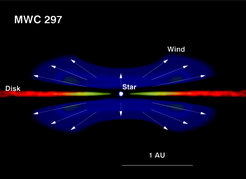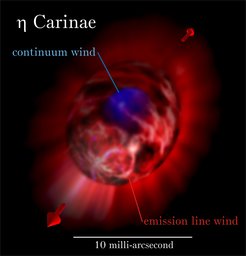Shedding New Light on the Life Cycle of Stars
First astrophysical results with the AMBER-VLT-interferometer
Astronomical measurements with AMBER and three telescopes of the VLT interferometer (VLTI) provide a resolution 16 times higher than each of the 8.2 meter telescopes alone. With a total mirror surface larger than 150 m² and a maximum separation greater than 130 m between the individual telescopes, the VLTI is currently the world's largest telescope and interferometer in the optical and infrared wavelength regime.
AMBER was built by a European consortium and successfully installed at the VLTI in March 2004. The infrared-interferometry group at the Max Planck Institute for Radio Astronomy in Bonn, lead by Prof. Gerd Weigelt, was in charge of building AMBER's infrared detector. "Thanks to its high spatial and spectral resolution, AMBER/VLTI opens a wealth of completely new insights in various fields of stellar astrophysics", says Gerd Weigelt. "This covers the whole range from the very early phases in the life of stars when the star is still accreting surrounding material, to the very late phases when large amounts of matter are blown away from the stars." The first scientific results obtained from AMBER observations, presented as a special feature in the latest issue of the journal Astronomy & Astrophysics, cover various topics in the field of stellar astrophysics.
Two papers deal with Herbig Ae/Be stars, a class of pre-main sequence stars with masses ranging from 2 to 5 solar masses and ages younger than 10 million years. The articles present observations of the star MWC 297 (see Fig. 1) and the lower-mass, less active star HD 104237. The AMBER measurements unveil new details about the outflowing winds and the geometry of the surrounding gas and dust disks in which new planets can form. These results illustrate AMBER's important role as a tool for studying the very close environment of young stars.

Three other AMBER-related articles presented in Astronomy & Astrophysics are devoted to the study of hot, active stars, which have already drawn astronomers' attention for quite a long time: Alpha Arae, one of the closest so-called Be stars; Kappa Canis Majoris, one of the brightest Be-stars known; and CPD -57°2874, a hot star with a peculiar emission-line spectrum. The AMBER observations of these objects provide novel information about the rotating gas envelopes of hot emission-line stars.
Among the massive stars observed with AMBER is the enigmatic object Eta Carinae. This star which showed a tremendous eruption roughly 160 years ago, is one of the most luminous and probably also most massive stars known today. Eta Carinae's mass is estimated to be as high as 100 times the mass of our Sun. Up to now, the reason for the great eruption, which formed the so-called Homunculus nebula, is still an open question. Using AMBER with its high spatial and spectral resolution, it was possible to zoom into the very heart of Eta Carinae. In this innermost region, the observations are dominated by the extremely dense stellar wind, which totally obscures the underlying central star. The AMBER observations show that this dense stellar wind is not spherically symmetric, but exhibits a clearly elongated structure. This significant deviation from spherical symmetry is present when Eta Carinae is observed in continuum light as well as in the light of a characteristic hydrogen emission line. The extensions of the regions where the continuum radiation and the hydrogen line-emission originate are remarkably different. While the size of the dense stellar wind in the continuum is only 10 Astronomical Units (corresponding to approximately 1.5 billion kilometers), AMBER measured a two times larger extension for the line-emitting region. Overall, the AMBER observations confirm that the extremely high mass loss of Eta Carinae's massive central star is non-spherical and much stronger in polar direction than in the equatorial plane. This is in agreement with theoretical models which predict such an enhanced polar mass-loss in the case of rapidly rotating stars.

A few other papers focus on the later stages in the life of single and interacting binary stars. Examples include the binary star Gamma2 Velorum and the recurrent nova RS Ophiuchi. Gamma2 Velorum is a binary consisting of a so-called Wolf-Rayet star and a hot star of spectral type O. The AMBER measurements of this system revealed that the observed emission lines originate in the zone where the strong stellar winds from both stars collide. The famous recurrent nova RS Ophiuchi, which showed a major eruption on February 12th 2006 after 21 years of quiescence, was observed with AMBER only 5 days after the discovery of the eruption. From these measurements, it was possible to study the geometry and the kinematics of the explosion in a very early phase after the event.
About AMBER:
AMBER (Astronomical Multi-BEam Recombiner) is one of two science instruments of the Very Large Telescope Interferometer (VLTI) of the European Southern Observatory at Cerro Paranal in Chile. It is an interferometric beam combiner for the VLTI, sensitive in the near-infrared wavelength range (from 1 to 2.5 microns). AMBER was built in collaboration with institutes from Grenoble (Laboratoire d'Astrophysique de Grenoble), Nice (Laboratoire d'Astrophysique Universitaire de Nice und Observatoire de la Côte d'Azur), Florence (Observatorio Astrofisico di Arcetri) and Bonn (Max Planck Institute for Radio Astronomy). The basic principle of the interferometric technique is to combine the light collected by two or more distant telescopes. The greater the distance between the telescopes, the sharper the observations attained. For the 8.2 meter telescopes of the VLTI in Chile, this distance can be up to 130 meters, providing observers with milli-arcsecond spatial resolution. With such high spatial resolution, 16 times higher than the resolution of a single 8.2 meter telescope, one should be able to distinguish details on the Moon that are approximately 2 meters in size. In addition to the high spatial resolution, AMBER also provides astronomers with high spectroscopic resolution. This allows, for instance, detailed measurements of stars in important absorption and emission lines. Thus, the AMBER instrument combines the high spatial resolution of an interferometer with the high spectral resolution of a spectrograph in a unique way.

